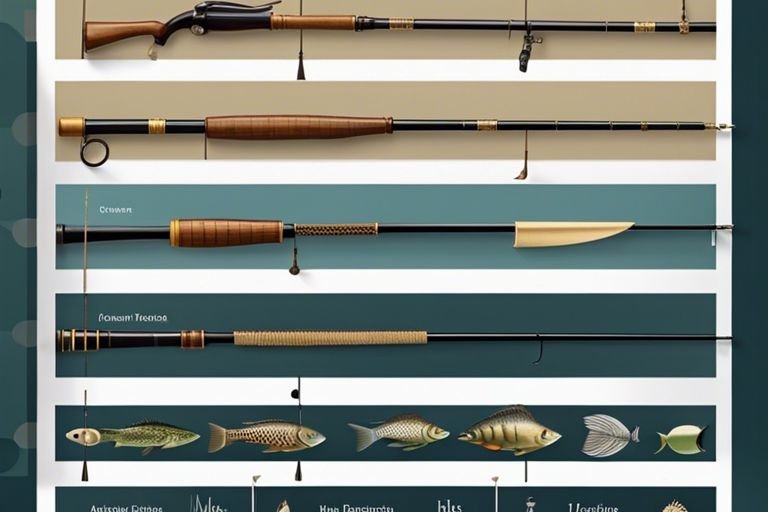fellow anglers! Let’s look into the fascinating world of fishing history and unravel the mystery of when fishing rods first appeared. Join me on a historical adventure to uncover the origins of this beloved fishing companion that has been casting lines for over 25 years. Archaeological evidence suggests that fishing rods were around as early as 2,000 BC, placing their invention within the prehistory of the fishing tackle era. To learn more about the evolution of fishing tools and techniques, check out this intriguing blog post here.
From humble beginnings as simple sticks to the high-tech equipment we use today, fishing rods have come a long way. Discover the global presence and independent invention of fishing rods across various cultures throughout history. Whether you’re a seasoned angler or just dipping your toes into the world of fishing, the journey of the fishing rod is sure to captivate and inspire.
So buckle up and let’s set sail on this educational voyage through the rich history of fishing and the timeless joy of casting a line.

Key Takeaways:
- Fishing rods have a long history: Archaeological evidence suggests fishing rods were around as early as 2,000 BC, placing their invention in the prehistoric era of fishing tackle development.
- The gradual evolution of fishing rods: While the exact date of invention remains a mystery, the development of fishing rods was a continuous process that evolved alongside humanity’s fishing techniques.
- Materials used in rod construction: Early fishing rods were likely crafted from simple materials like sticks and lines, but over time, materials such as bamboo became popular due to their lightweight flexibility and strength.
- Global presence of fishing rod invention: Evidence suggests that fishing rods were independently developed in different cultures around the world, from ancient Egypt to China.
- An enduring tool of angling: From humble beginnings to modern advancements, the fishing rod has been a constant companion to anglers throughout history, highlighting the timeless joy and importance of this age-old practice.
Origin of Fishing Rods Explored

Early Implements for Fishing
One of the fascinating aspects of exploring the roots of fishing rods is delving into the early implements our ancestors used for fishing. They didn’t have the sleek, high-tech rods we use today. Instead, imagine them with simple sticks and lines.
Archaeological evidence suggests that as far back as 2,000 BC, people were already using rudimentary tools for fishing, paving the way for the evolution of the fishing rod.
Early anglers likely improvised with whatever resources were available, highlighting the resourcefulness of our ancient counterparts in their pursuit of the catch.
Transition to Rods: Inferences from Archaeological Finds
An intriguing aspect of the development of fishing rods is examining the transition from basic fishing implements to the more sophisticated rods we are familiar with today.
The shift from using sticks and lines to more purpose-built rods was a gradual process. As fishing practices evolved, so did the materials and designs of the tools used.
Bamboo, known for its lightweight flexibility and durability, became a popular choice for crafting rods, reflecting the ingenuity of early anglers in utilizing natural resources to enhance their fishing experience.
Plus, the introduction of multi-section rods for ease of transport marked a significant innovation in the world of fishing. These rods allowed anglers to move around more freely, exploring different fishing spots without the burden of cumbersome equipment.
The adaptability and versatility of these new rod designs revolutionized the way anglers approached their favorite pastime, making fishing more accessible and enjoyable for aspiring fishers everywhere.
Ancient Rods Since 2,000 BC

Now, let’s research the fascinating world of ancient fishing rods, dating back to 2,000 BC. In the early days, our angler ancestors relied on simple sticks and lines to reel in their prized catches.
These basic tools might not have been as sophisticated as today’s sleek rods, but they got the job done!
Egyptian Papyrus Rod Depictions
An intriguing glimpse into ancient fishing practices can be found in Egyptian papyrus rod depictions.
These historical documents showcase the tools and techniques used by early Egyptian anglers, offering valuable insights into the development of fishing rods in this region.
Chinese Bamboo Rod References
An important milestone in fishing rod evolution was the use of bamboo in Chinese rod construction. The lightweight flexibility and impressive strength of bamboo made it a popular choice for anglers seeking to enhance their fishing experience.
With bamboo rods, anglers gained improved control and durability, revolutionizing the way they approached fishing. The introduction of multi-section rods for easier transport further revolutionized fishing practices, allowing anglers to navigate various water bodies with ease.
Development Gradual, Not Sudden
All fishing enthusiasts know that the history of the fishing rod is a long and winding one, with each new era bringing its improvements and advancements.
The History of the Fishing Rod is a testament to the ingenuity of our ancestors, who constantly sought to enhance their fishing experiences through incremental innovations across centuries.
Incremental Innovations Across Centuries
To witness the evolution of fishing rods is to witness the unstoppable progress of human creativity and adaptability. From the early days of simple sticks and lines to the sophisticated tools we use today, each generation added its touch to improve the fishing experience.
The gradual refinement of fishing rods shows the dedication of anglers throughout history to perfect their craft and reel in that prized catch.
Material Improvements from Wood to Metal
One of the most significant advancements in fishing rod development has been the shift from traditional materials like wood to more modern options like metal. This transition allowed for increased durability, flexibility, and overall performance in fishing rods.
With the introduction of materials like bamboo and metal alloys, anglers found themselves equipped with rods that could withstand the rigors of the water and provide a more seamless fishing experience.
Material improvements in fishing rods have not only enhanced the durability and performance of the equipment but have also opened up new possibilities for anglers to explore different fishing techniques and environments.
The evolution of materials used in fishing rod construction is a testament to the never-ending quest for improvement and innovation in the world of fishing.
Bamboo Revolutionizes Rod Materials
For centuries, anglers have relied on fishing rods crafted from various materials, each offering different benefits and drawbacks. But it was the bamboo revolution that truly changed the game in the world of fishing equipment.
Picture the early days of fishing, where anglers fashioned rods out of sturdy branches or reeds. Bamboo, with its lightweight flexibility and impressive strength, quickly became a favored material for rod construction.
The transition to bamboo rods marked a significant shift in the way anglers approached their craft. No longer were they limited by the constraints of heavier, bulkier materials. Instead, they could enjoy the benefits of a lightweight, durable, and flexible rod that enhanced their fishing experience.
Imagine the sheer convenience of having a rod made from bamboo – easy to transport, effortless to handle, and incredibly efficient in action. Anglers no longer had to struggle with cumbersome one-piece rods; instead, they could enjoy the flexibility of multi-section rods for enhanced portability.
The rise of bamboo in rod construction not only transformed the tools anglers used but also elevated their fishing experience. Effortless casting, smooth reel-ins, and durable construction were just some of the benefits anglers gained from this innovative material.
As we reflect on the evolution of fishing rods, it’s clear that the introduction of bamboo as a key material was a game-changer in the world of angling. The legacy of bamboo rods lives on, a testament to the ingenuity of anglers throughout history.
FAQs
Q: When were fishing rods first invented?
A: Fishing rods were likely invented as early as 2,000 BC during the prehistoric era of fishing tackle. While the exact date remains uncertain, archaeological evidence suggests their presence around this time.
Q: What materials were early fishing rods made from?
A: Early fishing rods were crafted from basic materials like sturdy branches or reeds. As fishing practices evolved, bamboo became a popular choice due to its lightweight flexibility and strength.
Q: How did fishing rods develop over time?
A: Fishing rods progressed from simple sticks to more sophisticated equipment, with innovations like multi-section rods for easier transport. The gradual evolution of fishing rods mirrored advancements in fishing techniques.
Q: Were fishing rods invented independently in different cultures?
A: Yes, evidence suggests that fishing rods were independently developed in various civilizations around the world. Different cultures, from ancient Egypt to China, contributed to the evolution of fishing rod design.
Q: What is the significance of fishing rods in history?
A: Fishing rods have been a constant companion to anglers throughout history, evolving from humble beginnings to the high-tech equipment used today. Their global presence across cultures highlights the importance and ingenuity of this important tool for fishing enthusiasts.






